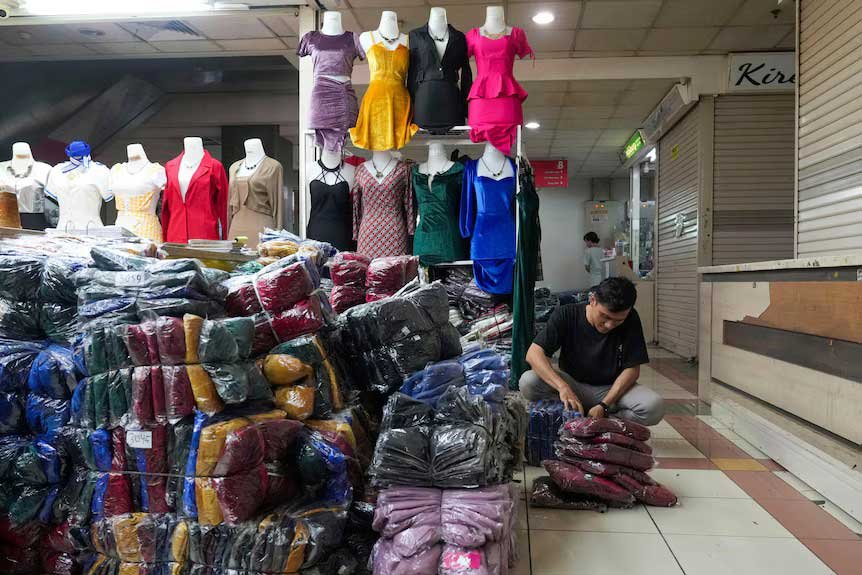Retail giant Temu had a meteoric rise to become the most downloaded shopping app worldwide in 2024, but despite that success the platform’s expansion plans hit roadblocks in some South-East Asian countries.
Owned by Chinese multinational PPD Holdings and founded by billionaire Colin Huang, Temu operates in more than 80 countries including Thailand, Malaysia, the Philippines and Australia.
Temu is a shopping website and app that sells a huge range of products like clothing, household items, and electronics at extremely low prices.
Its marketing strategies include gamification and advertising heavily on social media.
Temu’s largest market is the United States, where it aired commercials at the 2024 Super Bowl urging consumers to “shop like a billionaire”.
But that same year the retail giant’s plan to enter an e-commerce market worth billions of dollars stalled.
Temu was blocked in Indonesia, South-East Asia’s largest and most lucrative e-commerce market, valued at $US82 billion ($128 billion), according to data company Statista.
The ban was intended to protect small business from cheap products flooding the country and to capture import revenue.
Similar concerns have been raised in Vietnam, where Temu’s operations were suspended in December after the trade ministry voiced concerns over product quality and the impact the online retailer might have on Vietnamese manufacturers.
Temu tried multiple times to register a trademark in Indonesia last year and each time the Trade Ministry rejected the applications.
In October, the ministry ordered Apple and Google to block the Temu app so it could not be downloaded in Indonesia.
But with a population of 280 million people, e-commerce analyst Simon Torring thinks Temu might make another bid to access Indonesia.

“Temu is in a stage where they just want to serve the world,” said Mr Torring, co-founder of e-commerce data firm Cube.
“Being the fourth-most populous country in the world, it is not tenable to ignore [Indonesia] or not be there.”
While Temu is blocked — and fast fashion competitor Shein doesn’t sell clothes into Indonesia — other e-commerce retailers are flourishing.
Trade rules halt Temu
Indonesia’s Trade Ministry said it rejected Temu’s trademark applications because of the country’s trade regulations.
Those regulations require goods to be imported into Indonesia by a third party — like a local wholesaler or retailer — if the goods are sent from countries that do not have an import-related trade agreement with Indonesia.
Temu connects manufacturers — which the company refers to as “sellers” who are mostly based in China — directly with consumers, cutting out these intermediaries.
It’s one of the ways Temu keeps products cheap, in a business model that also makes manufacturers compete to offer the lowest product price.
Having a third party import goods into Indonesia is important to the country’s government because it guarantees that normal import duties and taxes are paid when the goods enter Indonesia, Mr Torring explained.
More of the final retail price is captured as domestic spending, he added.
Businesses cannot compete
The Temu ban is supported by Nandi Herdiaman, chairperson of the Bandung Garment Entrepreneurs Association that represents 8,000 home textile industry businesses across Indonesia.
Mr Herdiaman said Indonesians making clothing or other textiles for small businesses could not keep costs and product prices as low as items mass manufactured in China.
“We’ll definitely lose,” Mr Herdiaman said.
Other local industries, such as those making household items and electronics manufacturers would also be unable to “compete on cost” if Temu was allowed in Indonesia, said Muhammad Zulfikar Rakhmat, director of the China-Indonesia desk at the Jakarta-based Centre of Economic and Law Studies.
“They cannot match Temu’s pricing without sacrificing profit margins,” Dr Rakhmat said.
“Over time, this could lead to reduced market share and even closures for some businesses.”
Indonesia’s Trade Minister and Vice Trade Minister declined to comment.
While Temu is blocked, other e-commerce platforms like Shopee, owned by Singapore’s Sea Limited, and TikTok Shop and Lazada, owned by Chinese companies, are allowed to operate in Indonesia.
The key difference between these platforms and Temu is that the Chinese goods sold on those sites are imported into Indonesia by a trader or wholesale importer, Mr Torring said.

“Indonesia is very welcoming to foreign e-commerce players … it’s just that cross-border model that they don’t want,” he said.
“Local and foreign e-commerce platforms are allowed to operate if they are registered and if they are following business models that are legal.”
Mr Torring pointed out that many of the same items made in China are sold by the other online retailers in Indonesia, but the prices are higher because they use intermediaries in their supply chain.
He said Temu was now taking “serious steps” to change the platform’s cross-border model.
“In most of the western European countries and the US, most of the orders are actually fulfilled from local warehouses now.”
Temu declined to comment on the issues covered in this this story.
‘Nothing I can do’
Clothing business owner Dudi Gumilar is not concerned with which online retailers are allowed to operate in Indonesia.
“I don’t care whether Shopee, Temu, whatever, operate in Indonesia, I couldn’t care less,” he said.
For Mr Gumilar, the key issue is that Indonesian consumers still preferred to buy imported products over locally-made items.
It’s a well-known trend in Indonesia, which frustrated former president Joko Widodo who repeatedly urged consumers to buy items made in the country.
“Without the spirit of nationalism, the local small-medium businesses are doomed,”
Mr Gumilar said.
Mr Gumilar, who has run his company for two decades, said small to medium textile businesses needed more protection from the onslaught of imported goods.
“Nobody hears us even when we scream. There’s nothing I can do other than just working.”
Indonesia’s low de minimis
Indonesia was one of the first in South-East Asia to significantly reduce the country’s tax-free threshold for small or low-value packages.
Under the “de minimis” rule, parcels aren’t taxed if they’re valued under a certain amount — for example, in Australia that amount is $1,000.
Daniella Jacobs-Herd faces a decade of skin grafts after suffering severe burns from a Temu jumper purchased online, which failed to comply with Australian safety standards.
But in 2020, Indonesia reduced its threshold to a very low value, from $US75 to $US3 ($117 to $4.70).
Mr Torring said this low tax-free threshold prompted fast fashion brand Shein to leave Indonesia.
“It was no longer possible to be Shein in Indonesia. Shein is fast and cheap. Now it would be slow and not cheap,” he said.
“I would say that marked the start of when Indonesia’s e-commerce market was kind of closed to cross border e-commerce.”
Shein was contacted for comment but did not respond.
News Credit: https://www.abc.net.au/news/2025-02-28/why-temu-is-blocked-from-indonesia-s-lucrative-e-commerce-market/104979374












